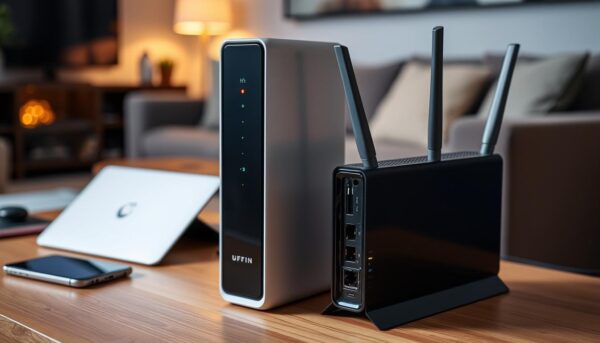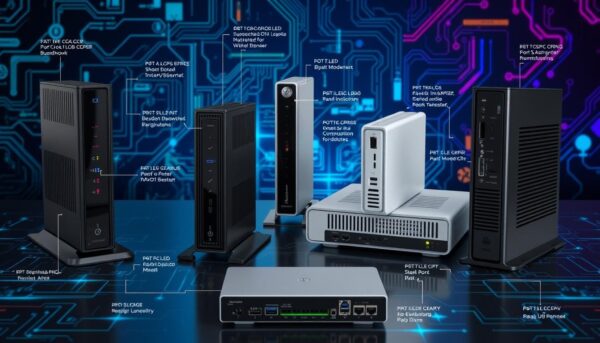✅ Last checked on
Are you fed up with slow internet and high rental costs? Picking the right modem for your Internet Service Provider (ISP) can change everything. It’s not just about getting online. It’s about getting the most out of your high-speed internet and maybe saving some cash too.
Broadband modems are the real heroes of our digital world. They turn the raw signals from your ISP into data your devices can use. Whether you’re streaming, gaming, or working from home, the right modem can make a huge difference.
Did you know renting a modem from your ISP can cost $60 to $120 a year? That’s money you could save by buying your own. Plus, the right modem could unlock speeds you never knew were possible on your current plan.
Let’s explore the world of modems and find the perfect one for your high-speed internet needs. We’ll cover everything from DOCSIS technology to comparing upload and download speeds. You’ll learn how to make a smart choice.
Key Takeaways
- Buying a modem can save you $60-$120 annually on rental fees
- DOCSIS 3.1 modems support speeds up to 10 Gbps
- Choose a modem compatible with your ISP and speed tier
- Consider future-proofing with higher speed capabilities
- The right modem can significantly improve your internet experience
Understanding Modem Basics and Technology
Choosing the right equipment for your internet connection can be tricky. Let’s break down the essentials of modems and related technology to help you make an informed decision.
What is DOCSIS and Why It Matters
DOCSIS, or Data Over Cable Service Interface Specification, is the standard protocol used by cable modems. It’s crucial because it determines the speeds your modem can handle. Older DOCSIS versions (1, 1.1, and 2) typically offer download speeds between 30-100 Mbps.
Newer versions like DOCSIS 3.0 and 3.1 can reach speeds over 1 Gbps. Some advanced models can even hit 10 Gbps for uploads.
Modem vs Router vs Gateway Differences
Cable modems connect your home to the Internet Service Providers’ network. Wi-Fi routers distribute this connection to multiple devices wirelessly. A gateway combines both functions in one unit.
Most routers use dual-band frequencies: 2.4GHz (longer range) and 5GHz (faster speeds).

Upload and Download Speed Specifications
When selecting a modem, consider both upload and download speeds. Typically, upload speeds are about 15% of download speeds. For example, a 200 Mbps download plan might offer 30 Mbps upload.
Match your modem’s capabilities to your Internet Service Providers’ plan for optimal performance.
| Usage Type | Recommended Bandwidth |
|---|---|
| Moderate to High | 1 Mbps per 2 employees |
| Low or Casual | 1 Mbps per 3 employees |
Remember, upgrading to DOCSIS 3.0 or 3.1 is often necessary for internet plans exceeding 100 Mbps. By understanding these basics, you’ll be better equipped to choose the right modem for your needs.
Best Modem ISP Compatibility Requirements
Choosing the right modem for your Internet Service Provider (ISP) is key for good Internet. Whether you’re looking at DSL or fiber optic modems, make sure they work with your ISP.
Major ISP Provider Support Lists
Big ISPs like Xfinity, Cox, and Spectrum have lists of approved modems on their sites. These lists help ensure your modem works well with your provider. For example, the ARRIS SURFboard S33 works with Xfinity and can reach speeds of up to 5,000 Mbps.
Speed Tier Compatibility
Your modem must match your internet plan’s speed. For example, the Netgear CM500 is great for mid-range plans, reaching speeds of up to 686 Mbps. If you want gigabit speeds, the Motorola MB8600 is a good choice, supporting over 1 Gbps.
Regional Availability Considerations
Modem choices can differ by location. Some ISPs, like Sparklight, need specific modems. They support cable modems but not DSL. Always check with your local ISP for the latest compatibility info.
| Modem Model | Max Speed (Download/Upload) | Channels (Down/Up) | Warranty |
|---|---|---|---|
| ARRIS SURFboard S33 | 5,000/2,000 Mbps | 32/8 | 2 years |
| Netgear CM500 | 686/132 Mbps | 16/4 | 1 year |
| Motorola MB7420 | 686/123 Mbps | 16/4 | 2 years |
| Netgear CM600 | 960/240 Mbps | 24/8 | 1 year |
Essential Features and Specifications to Consider
When picking Network Equipment like Broadband Modems, knowing key features is key. The DOCSIS version is crucial. DOCSIS 3.1 modems can handle speeds up to 10 Gbps download and 1 Gbps upload. This is great for those needing fast internet.
Channel bonding is also important. Modems with 32×8 channel bonding have 32 downstream and 8 upstream channels. This boosts speed and reliability. With more devices connected at home, this is essential.

Ethernet port speed matters too. Gigabit Ethernet ports can go up to 1 Gbps. This is vital for fast connections. Also, think about heat management and build quality. They affect how long your modem lasts and how well it works.
| Feature | Importance | Recommendation |
|---|---|---|
| DOCSIS Version | Determines speed capability | DOCSIS 3.1 for future-proofing |
| Channel Bonding | Improves speed and reliability | 32×8 or higher |
| Ethernet Port Speed | Affects maximum throughput | Gigabit Ethernet |
| Heat Management | Impacts longevity | Look for ventilation features |
| Build Quality | Affects durability | Sturdy construction, reputable brand |
Keep in mind, your ISP plan sets your actual speed. A modem that can do 1.4 Gbps won’t give you 25 Mbps if that’s your plan. Pick a modem that fits your current needs and future upgrades.
Cost Analysis: Buying vs Renting
Choosing a modem for your High-Speed Internet involves weighing buying versus renting costs. Many Internet Service Providers offer modem rentals. But is this the best financial choice for you?
Monthly Rental Fee Comparison
Let’s examine some rental fees from major ISPs:
| ISP | Monthly Fee | Annual Cost |
|---|---|---|
| Xfinity | $15.00 | $180.00 |
| CenturyLink | $15.00 | $180.00 |
| Cox | $10.99 | $131.88 |
| Frontier | $10.00 | $120.00 |
Long-term Investment Benefits
Buying your modem can save money in the long run. For instance, the Motorola MG7700 wireless gateway costs $129.99. This is $50 less than Xfinity’s annual rental fee. Over time, these savings add up.
Owning your modem also lets you control your home network setup.
Warranty and Support Considerations
Renting modems often includes free upgrades and replacements. But owning your modem means you handle troubleshooting. Still, many modems come with warranties. The money saved on rental fees can cover repair costs.
If you plan to stay with your Internet Service Provider for over a year, buying your modem can save a lot of money. Consider your needs, budget, and long-term plans to choose the best option for your High-Speed Internet setup.
Installation and Setup Process
Setting up your new modem is key to great Internet. With the right steps, you can get your network running smoothly fast.
Physical Connection Guidelines
First, plug your modem into the cable outlet and power. Most modems take a few minutes to start up. You’ll see LED lights showing if it’s connected.
For better speeds, use Ethernet cables for devices like gaming consoles. This connects them directly to your router.
ISP Registration Steps
To turn on your modem, register it with your Internet Service Provider (ISP). You’ll need your modem’s serial number and CMAC address. These are on the device.
Many ISPs have quick setup options. They can be done in about 30 minutes. This saves you money compared to hiring someone to do it.
Troubleshooting Common Issues
If setup problems come up, try these fixes:
- Make sure all cables are plugged in right
- Restart your modem and router
- Check if your internet line is working
- Use your ISP’s app or website for Wi-Fi setup
- Do a speed test to check if everything’s working
| ISP | Self-Installation Savings | Setup Method |
|---|---|---|
| Astound | $80 | Mail or pickup |
| CenturyLink | $99 | Free self-install |
| Cox | Varies | Virtual assistant |
By following these tips, you can set up your network easily. You’ll have reliable Internet without spending a lot on professional help.
Conclusion
Choosing the best modem for your ISP can really boost your internet experience. Cable modems, like those with DOCSIS 3.1, can reach speeds up to 10 Gbps. This is way faster than DSL modems, which top out at 100 Mbps.
When picking a modem, think about its compatibility, features, and any cost savings. Your modem should match your internet plan’s speed to avoid slowdowns. For example, a 1 Gbps modem won’t use a 5 Gbps plan fully.
Keep your modem in good shape and update its firmware regularly. This keeps it running smoothly. Where you place your router is also key for speed and coverage.
Getting the right modem does more than just speed up your internet. It can also save you money by avoiding rental fees. Whether you’re streaming, gaming, or working from home, the best modem ensures you get the most from your connection. Start researching or upgrading your modem today and see the difference for yourself.